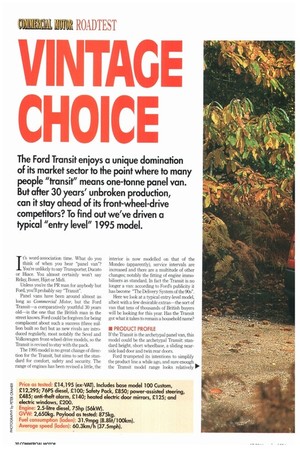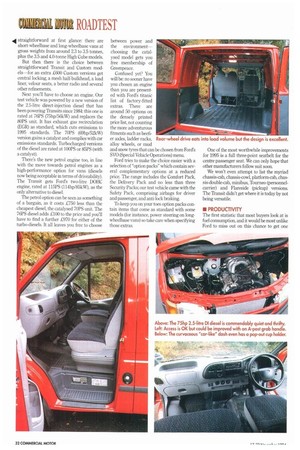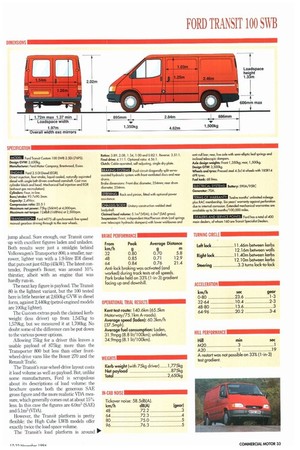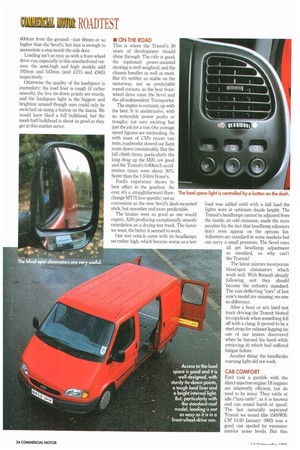11 NTAG CHOICE
Page 32

Page 34

Page 35

Page 36

Page 37

If you've noticed an error in this article please click here to report it so we can fix it.
The Ford Transit enjoys a unique domination of its market sector to the point where to many people "transit" means one-tonne panel van. But after 30 years' unbroken production, can it stay ahead of its front-wheel-drive competitors? To find out we've driven a typical "entry level" 1995 model.
It's word-association time. What do you think of when you hear "panel van"? You're unlikely to say Transporter, Ducato or Hiace. You almost certainly won't say Relay, Boxer, Hijet or Midi.
Unless you're the PR man for anybody but Ford, you'll probably say "Transit".
Panel vans have been around almost as long as Commercial Motor, but the Ford Transit—a comparatively youthful 30 years old—is the one that the British man in the street knows. Ford could be forgiven for being complacent about such a success (three million built so far) but as new rivals are introduced regularly, most notably the Sevel and Volkswagen front-wheel-drive models, so the Transit is revised to stay with the pack.
The 1995 model is no great change of direction for the Transit, but aims to set the standard for comfort, safety and security: The range of engines has been revised a little, the interior is now modelled on that of the Mondeo (apparently), service intervals are increased and there are a multitude of other changes; notably the fitting of engine immobilisers as standard. In fact the Transit is no longer a van: according to Ford's publicity it has become "The Delivery System of the 90s".
Here we look at a typical entry-level model, albeit with a few desirable extras—the sort of van that tens of thousands of British buyers will be looking for this year. Has the Transit got what it takes to remain a household name?
• PRODUCT PROFILE If the Transit is the archetypal panel van, this model could be the archetypal Transit: standard height, short wheelbase, a sliding nearside load door and twin rear doors.
Ford trumpeted its intentions to simplify the product line a while ago, and sure enough the Transit model range looks relatively • straightforward at first glance: there are short-wheelbase and long-wheelbase vans at gross weights from around 2,3 to 15 tonnes, plus the 3.5 and 40-tonne High Cube models.
But then there is the choice between straightforward Transit and Custom models—for an extra £600 Custom versions get central locking, a mesh half-bulkhead, a load liner, velour seats, a better radio and several other refinements.
Next you'll have to choose an engine. Our test vehicle was powered by a new version of the 2.5-litre direct-injection diesel that has been powering Transits since 1984: this one is rated at 76PS (75hp/56kW) and replaces the 80PS unit. It has exhaust gas recirculation (EGR) as standard, which cuts emissions to 1995 standards. The 70PS (69hp/52kW) version gains a catalyst and complies with car emissions standards. Turbocharged versions of the diesel are rated at 100PS or 85PS (with a catalyst).
There's the new petrol engine too, in line with the move towards petrol engines as a high-performance option for vans (diesels now being acceptable in terms of driveability). The Transit gets Ford's two-litre DOHC engine, rated at 115PS (114hp/85kW), as the only alternative to diesel.
The petrol option can be seen as something of a bargain, as it costs £750 less than the cheapest diesel, the catalysed 70PS unit. The 76PS diesel adds £100 to the price and you'll have to find a further £970 for either of the turbo-diesels. It all leaves you free to choose between power and the environment— choosing the catalysed model gets you free membership of Greenpeace.
Confused yet? You will be: no sooner have you chosen an engine than you are presented with Ford's titanic list of factory-fitted extras. There are around 50 options on the densely printed price list, not counting the more adventurous fitments such as beefier axles, ladder racks, alloy wheels, or mud and snow tyres that can be chosen from Ford's SVO (Special Vehicle Operations) menu.
Ford tries to make the choice easier with a selection of "option packs" which contain several complementary options at a reduced price. The range includes the Comfort Pack, the Delivery Pack and no less than three Security Packs; our test vehicle came with the Safety Pack, comprising airbags for driver and passenger, and anti-lock braking.
To keep you on your toes option packs contain items that come as standard with some models (for instance, power steering on longwheelbase vans) so take care when specifying those extras. One of the most worthwhile improvements for 1995 is a full three-point seatbelt for the centre passenger seat. We can only hope that other manufacturers follow suit soon.
We won't even attempt to list the myriad chassis-cab, chassis-cowl, platform-cab, chassis-double-cab, minibus, Tourneo (personnelcarrier) and Flareside (pickup) versions. The Transit didn't get where it is today by not being versatile.
• PRODUCTIVITY The first statistic that most buyers look at is fuel consumption, and it would be most unlike Ford to miss out on this chance to get one jump ahead. Sure enough, our Transit came up with excellent figures laden and unladen. Both results were just a smidgin behind Volkswagen's Transporter 800, a smaller, nar rower, lighter van with a 1.9-litre diesel that puts out just 61hp (45kW). The latest contender, Peugeot's Boxer, was around 10% thirstier, albeit with an engine that was hardly run-in.
The next key figure is payload. The Transit 80 is the lightest variant, but the 100 tested here is little heavier at 2,650kg GVW in diesel form, against 2,440kg (petrol-engined models are 100kg lighter).
The Custom extras push the claimed kerbweight (less driver) up from 1,547kg to 1,579kg, but we measured it at 1,700kg. No doubt some of the difference can be put down to the various power options.
Allowing 75kg for a driver this leaves a usable payload of 875kg: more than the Transporter 800 but less than other frontwheel-drive vans like the Boxer 270 and the Renault Trafic.
The Transit's rear-wheel-drive layout costs it load volume as well as payload. But, unlike some manufacturers, Ford is scrupulous about its descriptions of load volume: the brochure quotes both the generous SAE gross figure and the more realistic VDA measure, which generally comes out at about 15% less. In this case the figures are 6.0m3 (SAE) and 5.10 (VDA).
However, the Transit platform is pretty flexible: the High Cube 1...WB models offer exactly twice the load space volume.
The Transit's load platform is around illo• 600hnin from the ground—just 60mm or so higher than the Severs, but that is enough to necessitate a step inside the side door.
Loading isn't as easy as with a front-wheel drive van, especially in this standard-roof version; the semi-high and high models add 192mm and 542mm (and £215 and £945) respectively.
Otherwise the quality of the loadspace is exemplary: the load liner is tough (if rather smooth), the five tie-down points are sturdy, and the loadspace light is the biggest and brightest around though ours could only be switched on using a button on the fascia. We would have liked a full bulkhead, but the mesh half-bulkhead is about as good as they get in this market sector.
• ON THE ROAD
This is where the Transit's 30 years of development should shine through. The ride is good, the (optional) power-assisted steering is well weighted, and the chassis handles as well as most. But it's neither as stable on the motorway, nor as predictable round corners, as the best frontwheel drive vans: the Sevel and the all-independent Transporter.
The engine is certainly up with the best. It is unobtrusive, with no noticeable power peaks or troughs; not very exciting but just the job for a van. Our average speed figures are misleading. As with most of CMs recent van tests, roadworks slowed our Kent route down considerably. But the hill climb times, particularly the long drag up the M20, are good and the Transit's 0-80km/h acceleration times were about 30% faster than the 1.9-litre Boxer's.
Ford's experience shows to best effect in the gearbox. As ever, it's a straightforward floorchange MT75 five-speeder; not as convenient as the new Severs dash-mounted stick, but smoother and more predictable.
The brakes were as good as one would expect, ABS producing exceptionally smooth retardation on a drying test track. The faster we went, the better it seemed to work.
Our test vehicle came with its headlamps set rather high, which became worse as a test load was added until with a full load the lights were at optimum dazzle height The Transit's headlamps cannot be adjusted from the inside; an odd omission, made the more peculiar by the fact that headlamp adjusters don't even appear on the options list. Adjusters are standard in some markets but can carry a small premium. The Sevel vans all get headlamp adjustment as standard, so why can't the Trannie?
The latest mirrors incorporate blind-spot eliminators which work well. With Renault already following suit they should become the industry standard. The rain-deflecting "ears" of last year's model are missing we saw no difference.
After a hour or so's hard test track driving the Transit blotted its copybook when something fell off with a clang. It proved to be a steel strap for exhaust lagging (as one of our testers discovered when he burned his hand while retrieving it) which had suffered fatigue failure.
Another thing: the handbrake warning light did not work.
CAB COMFORT
Ford took a gamble with the direct-injection engine: DI engines are inherently efficient, but do tend to be noisy. They rattle at idle ("taxi-rattle", as it is known) and can sound harsh at speed. The last naturally aspirated Transit we tested (the 150SWB; CM 14-20 January 1993) was a good van spoiled by excessive interior noise levels. But this model, despite lacking a full bulkhead, was substantially quieter. This is possibly the most important result of Ford's redesign of the Transit's driving area The low-built cab is reasonably easy to get into and the driving position is much lower (with a less commanding driving position) than the Severs but we would have liked to have seen a grab-handle on the A-pillar.
What Ford describes as a "car-like" dashboard is curvaceous and well designed, but the lower half of the main moulding should have been more firmly anchored; it doesn't feel as solid as the Severs. The instruments are clear and well-placed, of course; in fact, our only complaint (apart from that defective handbrake light) is that the red segment on the fuel gauge is too bright. Er, that's it.
The new dash incorporates a clip for a notepad and an ingenious, if flimsy-looking,
pop-out cup-holder a CM tester's wishes answered_ The door bins are a good size and the glove compartment does not seem to have suffered too much by the inclusion of a fullsize (60-litre) passenger's-side airbag.
The driving position is so car-like, with the steering wheel mounted so low, that if you're turning left and changing gear at the same time your clutch foot will cancel the indicator.
The seats are invitingly plump and wellupholstered, and the Custom model gets a use ful inflatable lumbar support. But the dual passenger seat has a severely upright back, which cannot be adjusted. This seems a reasonable price to pay for anchoring that central shoulder strap.
We were a little disappointed by a couple of clues to slightly suspect build quality in the cab: bits of untrimmed plastic on the edge of the mouldings and a cigarette lighter that was easily pulled out of its hole.
• SUMMARY Overall, the 1995 Transit is a success; the cab is very comfortable, it's easy to drive, the loadspace is OK, performance is good and economy is excellent. If the only criterion is driver appeal there are few arguments against the Transit. Ford has stretched service intervals to 10,000 miles, too. But the Transit isn't cheap: with all its extras our "entry-level" test vehicle came in at precisely £5,000 more than the Renault Trafic Prima. Fortunately many of the best features are built in at the base price: the engine immobiliser, for instance.
In the long term Ford will have to take a good look at the Transit. Its front-wheel-drive rivals have drawn ahead in terms of load volume, payload and handling. Rear-wheel drive has traction advantages at heavy weights, but the current platform cannot last forever.
However, Ford has a history of learning from its rivals, along with the engineering knowhow and contacts to produce class-leading vehicles. It's a fair bet that Transit will still mean "panel van" in another 30 years' time. 0 by Toby Clark






















































































































